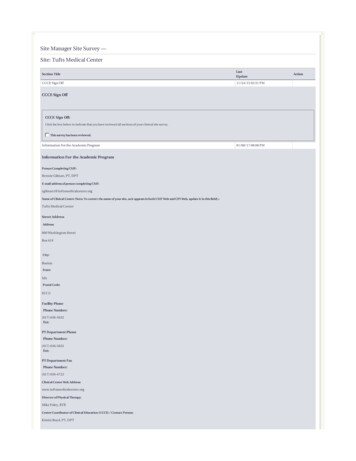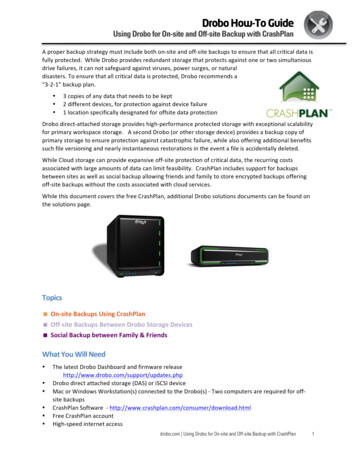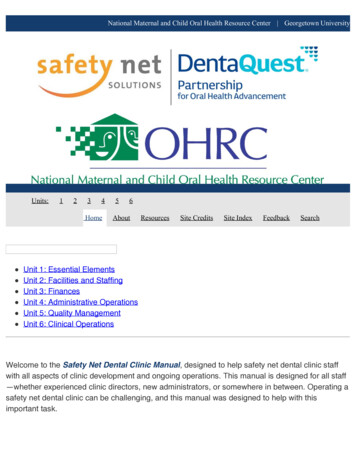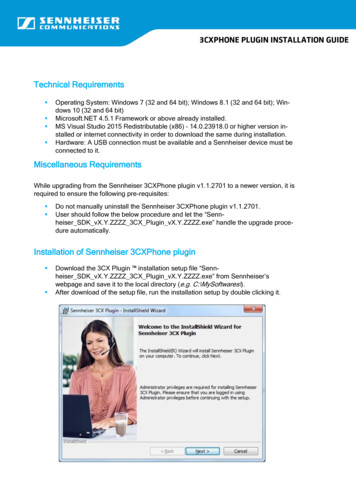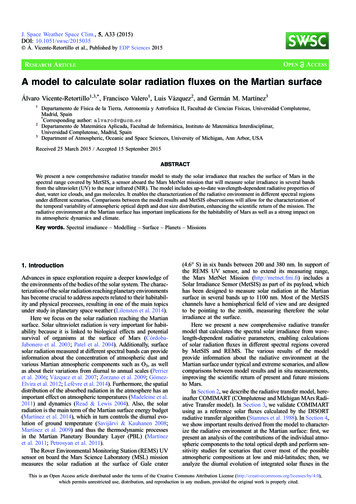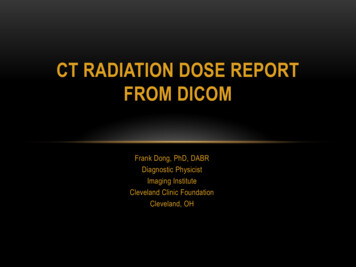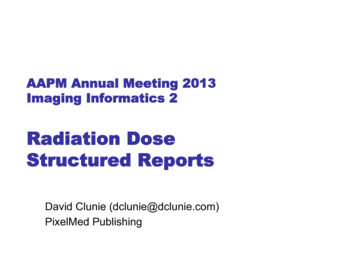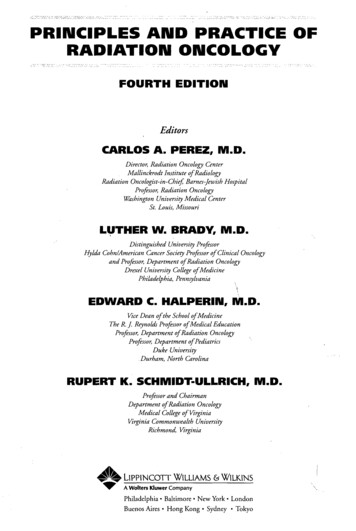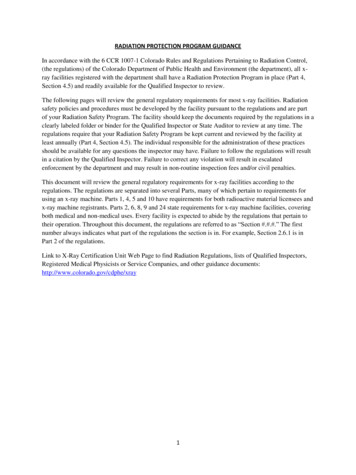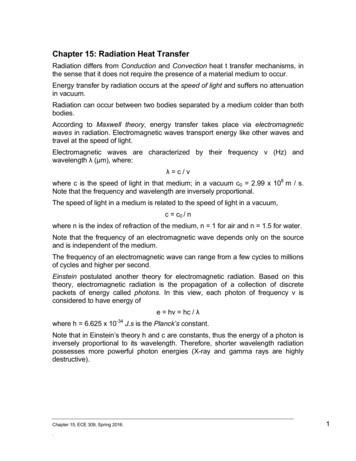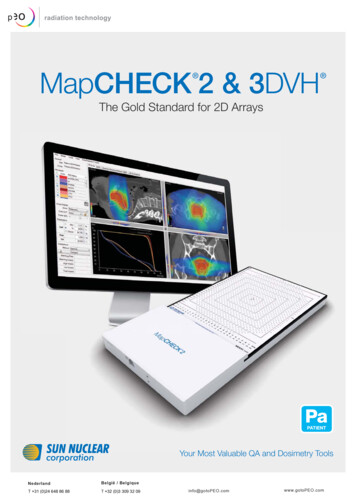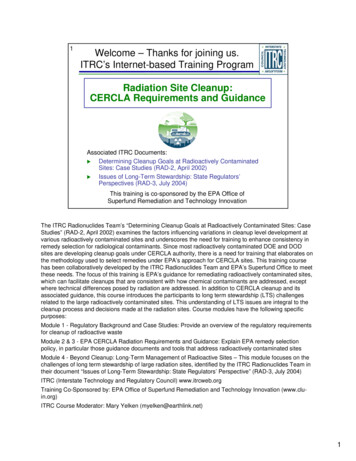
Transcription
1Welcome – Thanks for joining us.ITRC’s Internet-based Training ProgramRadiation Site Cleanup:CERCLA Requirements and GuidanceAssociated ITRC Documents:XDetermining Cleanup Goals at Radioactively ContaminatedSites: Case Studies (RAD-2, April 2002)XIssues of Long-Term Stewardship: State Regulators’Perspectives (RAD-3, July 2004)This training is co-sponsored by the EPA Office ofSuperfund Remediation and Technology InnovationThe ITRC Radionuclides Team’s “Determining Cleanup Goals at Radioactively Contaminated Sites: CaseStudies” (RAD-2, April 2002) examines the factors influencing variations in cleanup level development atvarious radioactively contaminated sites and underscores the need for training to enhance consistency inremedy selection for radiological contaminants. Since most radioactively contaminated DOE and DODsites are developing cleanup goals under CERCLA authority, there is a need for training that elaborates onthe methodology used to select remedies under EPA’s approach for CERCLA sites. This training coursehas been collaboratively developed by the ITRC Radionuclides Team and EPA’s Superfund Office to meetthese needs. The focus of this training is EPA’s guidance for remediating radioactively contaminated sites,which can facilitate cleanups that are consistent with how chemical contaminants are addressed, exceptwhere technical differences posed by radiation are addressed. In addition to CERCLA cleanup and itsassociated guidance, this course introduces the participants to long term stewardship (LTS) challengesrelated to the large radioactively contaminated sites. This understanding of LTS issues are integral to thecleanup process and decisions made at the radiation sites. Course modules have the following specificpurposes:Module 1 - Regulatory Background and Case Studies: Provide an overview of the regulatory requirementsfor cleanup of radioactive wasteModule 2 & 3 - EPA CERCLA Radiation Requirements and Guidance: Explain EPA remedy selectionpolicy, in particular those guidance documents and tools that address radioactively contaminated sitesModule 4 - Beyond Cleanup: Long-Term Management of Radioactive Sites – This module focuses on thechallenges of long term stewardship of large radiation sites, identified by the ITRC Radionuclides Team intheir document “Issues of Long-Term Stewardship: State Regulators’ Perspective” (RAD-3, July 2004)ITRC (Interstate Technology and Regulatory Council) www.itrcweb.orgTraining Co-Sponsored by: EPA Office of Superfund Remediation and Technology Innovation (www.cluin.org)ITRC Course Moderator: Mary Yelken (myelken@earthlink.net)1
2ITRC (www.itrcweb.org) – Shaping theFuture of Regulatory AcceptanceXXXNetwork State regulators Federal government Industry Consultants Academia Community stakeholdersDocuments Technical and regulatoryguidance documents Technology overviews Case studiesTraining Internet-based ClassroomHost OrganizationITRC State MembersITRC Member StateFederalPartnersDOEDODEPAThe Interstate Technology and Regulatory Council (ITRC) is a state-led coalition ofregulators, industry experts, citizen stakeholders, academia and federal partners that work toachieve regulatory acceptance of environmental technologies and innovative approaches.ITRC consists of 49 states (and the District of Columbia) that work to break down barriersand reduce compliance costs, making it easier to use new technologies and helping statesmaximize resources. ITRC brings together a diverse mix of environmental experts andstakeholders from both the public and private sectors to broaden and deepen technicalknowledge and advance the regulatory acceptance of environmental technologies. Together,we’re building the environmental community’s ability to expedite quality decision makingwhile protecting human health and the environment. With our network approaching 7,500people from all aspects of the environmental community, ITRC is a unique catalyst fordialogue between regulators and the regulated community.For a state to be a member of ITRC their environmental agency must designate a StatePoint of Contact. To find out who your State POC is check out the “contacts” section atwww.itrcweb.org. Also, click on “membership” to learn how you can become a member of anITRC Technical Team.2
3ITRC Disclaimer and CopyrightAlthough the information in this ITRC training is believed to be reliable and accurate,the training and all material set forth within are provided without warranties of anykind, either express or implied, including but not limited to warranties of theaccuracy, currency, or completeness of information contained in the training or thesuitability of the information contained in the training for any particular purpose. ITRCrecommends consulting applicable standards, laws, regulations, suppliers ofmaterials, and material safety data sheets for information concerning safety andhealth risks and precautions and compliance with then-applicable laws andregulations. ECOS, ERIS, and ITRC shall not be liable for any direct, indirect,incidental, special, consequential, or punitive damages arising out of the use of anyinformation, apparatus, method, or process discussed in ITRC training, includingclaims for damages arising out of any conflict between this the training and any laws,regulations, and/or ordinances. ECOS, ERIS, and ITRC do not endorse orrecommend the use of, nor do they attempt to determine the merits of, any specifictechnology or technology provider through ITRC training or publication of guidancedocuments or any other ITRC document.Copyright 2007 Interstate Technology & Regulatory Council,444 North Capitol Street, NW, Suite 445, Washington, DC 20001Here’s the lawyer’s fine print. I’ll let you read it yourself, but what it says briefly is: We try to be as accurate and reliable as possible, but we do not warrantee this material. How you use it is your responsibility, not ours. We recommend you check with the local and state laws and experts. Although we discuss various technologies, processes, and vendor’s products, we are notendorsing any of them. Finally, if you want to use ITRC information, you should ask our permission.3
4ITRC Course Topics Planned for 2007Popular courses from 2006XXXXXXXXXCharacterization, Design,Construction, and Monitoring ofBioreactor LandfillsDirect Push Well Technology forLong-term MonitoringEvaluate, Optimize, or End PostClosure Care at MSW LandfillsPerchlorate: Overview of Issues,Status and Remedial OptionsPlanning & Promoting EcologicalRe-use of Remediated SitesReal-Time Measurement ofRadionuclides in SoilRemediation ProcessOptimization Advanced TrainingRisk Assessment and RiskManagementSite Investigation andRemediation for MunitionsResponse ProjectsNew in 2007XXXXXPerformance-based EnvironmentalManagementProtocol for Use of Five PassiveSamplersSurvey of Munitions ResponseTechnologiesVapor Intrusion Pathway: APractical GuidelineMore in development Training dates/details atwww.itrcweb.orgTraining archives athttp://cluin.org/live/archive.cfmMore details and schedules are available from www.itrcweb.org under “Internet-basedTraining.”4
5Radiation Site Cleanup: CERCLARequirements and GuidanceLogistical RemindersPresentation Overview Phone line audience 9 Keep phone on mute9 *6 to mute, *7 to un-mute to askquestion during designatedperiods9 Do NOT put call on hold Simulcast audience9 Useat the top of eachslide to submit questions Course time 2¼ hours Introduction and course overviewModule 1: Radiation regulatorybackground and case studiesModule 2: Overview of CERCLArequirementsQuestions and answersModule 3: CERCLA radiationguidance and toolsModule 4: Beyond clean-up:challenges of long-termmanagement of radiation sitesLinks to additional resourcesYour feedbackQuestions and answersIntroduction and Course Overview – Provides the overview and learning expected from thiscourseModule 1 - Regulatory Background and Case Studies: Provide an overview of the regulatoryrequirements for cleanup of radioactive wasteModule 2 & 3 - EPA CERCLA Radiation Requirements and Guidance: Explain EPA remedyselection policy, in particular those guidance documents and tools that address radioactivelycontaminated sitesModule 4 - Beyond Cleanup: Long-Term Management of Radioactive Sites – This modulefocuses on the challenges of long term stewardship of large radiation sites, identified by theITRC Radionuclides Team in their document “Issues of Long-Term Stewardship: StateRegulators’ Perspective” (RAD-3, July 2004)5
6Meet the ITRC InstructorsTom SchneiderCarl SprengOhio EPADayton, o Deptof Public HealthDenver, CO303-692-3358Carl.Spreng@state.co.usRobin AndersonStuart WalkerEPA Office SuperfundRemediation andTechnologyInnovationWashington, DC703-603-8747Anderson.RobinM@epa.govEPA Office SuperfundRemediation andTechnologyInnovationWashington, DC703-603-8748Walker.Stuart@epa.govTom Schneider has worked for Ohio EPA in the area of radioactive site remediation since 1990. In hispresent capacity with Ohio EPA's Office of Federal Facilities Oversight, Mr. Schneider manages a team(composed of staff and contractors) charged with implementing Ohio's oversight and environmentalmonitoring program at the U.S. Department of Energy (DOE) Fernald site. Tom has a Masters of Science(M.S.) Degree in Natural Resources from the Ohio State University and a Bachelors of Science (B.S.)Degree in Biology from the University of Dayton. He is co-leader of the ITRC Radionuclides Team.Carl Spreng worked as an energy exploration geologist after receiving BS and MS degrees in Geologyfrom BYU. Since 1992 he has worked for the Colorado Department of Public Health and Environment asa project manager overseeing environmental restoration at DOE’s Rocky Flats site. He currently alsoserves as co-team leader of the Radionuclides Team of the Interstate Technology and Regulatory Council(ITRC).Robin Anderson has a BS in Chemistry from Washington State University, Pullman, Washington. Shehas approximately 25 years of service to the EPA, much of which centered on site cleanup and wastemanagement. Robin Anderson has worked in the Superfund program in the Office of Superfund andTechnology Innovation since 1989 on issues related to remedy selection, and compliance with applicable,or relevant, and appropriate requirements.Stuart Walker has a BA in political science and economics from the American University in Washington,DC and a MPA in policy analysis and development from George Washington University in Washington,DC. He has over 15 years in EPA working either on regulatory compliance or regulation development.Stuart Walker has been employed by U.S. EPA since 1990 in either the Superfund program (the Office ofSuperfund Remediation and Technology Innovation) or the Office of Radiation and Indoor Air working onissues regarding the cleanup of contaminated sites. His primary areas of responsibility include serving asthe Superfund program's national lead on issues regarding radioactively contaminated CERCLA sites. Inthis latter role, Stuart develops national policy for characterization, cleanup and management ofradioactive contamination at CERCLA sites. Previously Stuart was the lead staff person on remedyselection issues for EPA's CERCLA reauthorization team.6
7ITRC Radionuclides TeamXXFacilitate the cleanup of radioactively contaminated federalfacilities by fostering dialogue between states, stakeholders,and federal agencies in order to increase awareness ofissues and procedures at sites in other states, encourageregulatory cooperation, and share technological successesand approachesCurrent state members Colorado Ohio New Jersey Tennessee New Mexico WashingtonMade up of state and federal regulators, Dept. Energy personnel, consultants, and citizenstakeholders primarily from states with large DOE sites.Facilitate communication and experience sharing among sites7
8ITRC Team Products and ActivitiesXXXXXXRadiation Reference Guide: Relevant Organizations andRegulatory Terms (RAD-1, December 1999)Determining Cleanup Goals at Radioactively ContaminatedSites: Case Studies (RAD-2, April 2002)Issues of Long-Term Stewardship: State Regulators’Perspectives (RAD-3, July 2004)Real-Time Data Collection for Radionuclides: MeasurementTechnologies, Methodologies, Case Studies and RegulatoryIssues (RAD-4, February 2006)Radiation Risk Assessment Internet-based Training with USEPAReal-Time Radiation Internet-based TrainingDetails available in Links page at end ofpresentation or directly at www.itrcweb.orgThe products above have been developed by ITRC’s Radionuclides Team – details atwww.itrcweb.orgD & D – Decommissioning and Decontamination8
9Major Federal Laws on RadiationProtectionXXXXAtomic Energy Act (1954) Weapons development,nuclear power plantsMarine Protection,Research, and SanctuariesAct (1972)Energy Reorganization Act(1974)Safe Drinking Water Act(1974) Permissible levels(MCLs) of radionuclidesin drinking water systemsXXXXClean Air Act Amendments(1977) NESHAPSUranium Mill TailingsRadiation Control Act of1978 - UMTRCA (1978) Uranium mining/millingComprehensiveEnvironmental Response,Compensation, and LiabilityAct - CERCLA (1980) Site cleanupNuclear Waste Policy Act(1982) Yucca MountainRegulations are complex due to:multiple agencies,overlapping authorities, andmultiple categories of radioactive materials.UMTRCA – Uranium Mill Tailings Radiation Control ActCERCLA – Comprehensive Environmental Response, Compensation, and Liability Act9
10Major Categories of RadioactiveMaterialsXXXXXSource materials *Special nuclear material *By-product materials and mill tailings *Naturally occurring radioactive material (NORM)Naturally occurring or accelerator-producedradioactive material (NARM)* Associated with atomic energy productionAgencies regulating nuclear materials:U.S. Environmental Protection Agency (EPA)U.S. Nuclear Regulatory Commission (NRC)U.S. Department of Transportation (DOT)U.S. Department of Energy (DOE)Defense Nuclear Facility Safety Board (DNFSB)Various state agencies10
11What you will learn XXXXXXTo facilitate remedy selection and cleanup atradioactively-contaminated sites by explainingCERCLA requirements and policyDevelopment of clean-up levels in case studies fromsites contaminated with radionuclidesOverview of CERCLA requirements for cleanup ofradioactive contaminationCERCLA cleanup criteria and cleanup levelsCERCLA radiation guidanceCommon radiological ARARsChallenges of long-term management of radiationsitesARAR- Applicable or Relevant and Appropriate Requirements11
12Training Course OverviewMODULE 1: Radiation regulatory background andcase studiesMODULE 2: Overview of CERCLA requirementsMODULE 3: CERCLA radiation guidance and toolsMODULE 4: Beyond clean-up: challenges of longterm management of radiation sitesThis training is meant to provide an overview of cleanup and long-term management ofradioactively contaminated sites. Since most rad sites are regulated by CERCLA and itsrisk-based standards, the ITRC Radionuclides team developed this training to assist the sitemanagers, state regulators and others associated with cleanup and management of radsites.The first module, describing the cleanup at various radioactively contaminated sites withinthe DOE complex, is based on the ITRC’s Radionuclides Team’s document “DeterminingCleanup Goals at Radioactively Contaminated Sites: Case Studies” (RAD-2, April 2002).Since DOE has the largest share of radioactively contaminated sites and the biggestcleanup effort, we chose ot focus on the major DOE sites for the case studies.Module 2 and 3 provide overview of CERCLA requirements and specific guidance related tothese requirements. These provide detailed information on what is expected for cleanup atCERCLA sites and what are the tools/guidance available to comply with the requirements.Module 4 introduces challenges of post cleanup long-term management and relatedpublication developed by ITRC Radionuclides Team [Based on ITRC document: “Issues ofLong-Term Stewardship: State Regulators’ Perspectives” (RAD-3, July 2004)]12
13AcronymsAEAALARAAtomic Energy ActAs Low As ReasonablyAchievableARARsApplicable or Relevant andAppropriate RequirementsATSDRAgency for ToxicSubstances and DiseaseRegistryCAAClean Air ActCERCLA ComprehensiveEnvironmental Response,Compensation, andLiability ActCERCLIS ComprehensiveEnvironmental Response,Compensation, and LiabilityInformation SystemCFRCode of Federal RegulationsDCFDose Conversion FactorEDEEffective Dose EquivalentHEAST Health Effects AssessmentsSummary TablesHIHazard IndexHRSHazard Ranking SystemICRPInternational Commission onRadiological ProtectionLTRALong-Term Response ActionsMCLsMaximum Contaminant LevelsMOUMemorandum ofUnderstandingmilliremNaturally Occurring orAccelerator-ProducedRadioactive MaterialNational Oil and HazardousSubstances PollutionContingency PlanNaturally OccurringRadioactive MaterialmremNARMNCPNORMAcronym list for reference13
14Acronyms (continued)NPLNational Priorities ListRESRADNRCNuclear RegulatoryCommissionComputer model for ResidualRadioactive materialsRfDReference DoseNTCNon-Time CriticalRI/FSOSCOn Scene CoordinatorRemedial Investigation/Feasibility StudyOSWER Office of Solid Waste andEmergency ResponseRMEReasonable MaximumExposurePA/SIPreliminary Assessment/SiteInvestigationRODRecord of DecisionRPMRemedial Project ManagerpCipicocurieSDWASafe Drinking Water ActPRBPermeable Reactive BarrierSSGSoil Screening GuidancePRGPreliminary Remedial GoalSSLSoil Screening LevelRCRAResource Conservation andRecovery ActRD/RARemedial Design/RemedialActionUMTRCA Uranium Mill TailingsRadiation Control Act of 1978WLWorking LevelAcronym list for reference14
15Radiation Site Cleanup:CERCLA Requirements andGuidanceMODULE 1:1Radiation Regulatory Backgroundand Case StudiesNo associated notes15
16ITRC Radionuclides Team“Determining CleanupGoals at RadioactivelyContaminated Sites:Case Studies”(RAD-2, April 2002)Download at:www.itrcweb.org under“Guidance Documents”This document published in 2002 summarizes the various regulatory standards andrequirements that dictate cleanup at radioactively contaminated sites. It reports processesused to develop cleanup levels and presents case studies from 12 selected sites todemonstrate variations in decision-making framework and basis. This document can befound atwww.itrcweb.orgClick on Æ Guidance Documents (under ITRC icon)Click on Æ RadionuclidesClick on Æ Determining Cleanup Levels at Radioactively-Contaminated Sites (PDF file)16
17Case Studies1. Brookhaven, NY2. Enewetak Atoll3. Fernald, OH4. Fort Dix, NJ5. Hanford, WA6. Johnston Atoll7. Linde Site, NY8. Tonapah, NV9. Oak Ridge, TN10. Rocky Flats, CO11. Savannah River Site, SC12. Weldon Spring, MOCase studies:Brookhaven National Laboratory, New YorkEnewetak Atoll, Marshall IslandsFernald Environmental Management Project, OhioFort Dix, New JerseyHanford Site, WashingtonJohnston AtollLinde Site, New YorkNevada Test Site and Associated Ranges, Tonapah, NevadaOak Ridge, TennesseeRocky Flats, ColoradoSavannah River Site, South CarolinaWeldon Spring Site, Missouri17
18Radiological Cleanup Standards:Variation and InfluenceDifferent Regulatory AuthoritiesDifferent Regulatory StandardsDifferent Methodologies for CalculatingCleanup GoalsCleanup authorities:CERCLARCRANRC decommissioning criteriaDOE ordersState radiation control regulationsEtc.18
19Case StudiesXDifferences in cleanup levels due to differences in Regulatory authorityRadiation standards / ARARsHealth assessment approachesLand uses / exposure scenariosComputer codesInput parametersPhysical settingsState and community acceptanceTypes of cleanup goals reportedNo associated notes19
20Major U.S. Radiation StandardsRegulationAgencyStandard / Numerical limitGeneral publicNRC100 millirem/yearUranium mill tailingsEPA;NRCRa-226/228: 5/15 pCi/g(surface/subsurface)Rn-222: 20
Closure Care at MSW Landfills XPerchlorate: Overview of Issues, Status and Remedial Options XPlanning & Promoting Ecological . monitoring program at the U.S. Department of Energy (DOE) Fernald site. Tom has a Masters of Science . from BYU. Since 1992 he has worked for th
